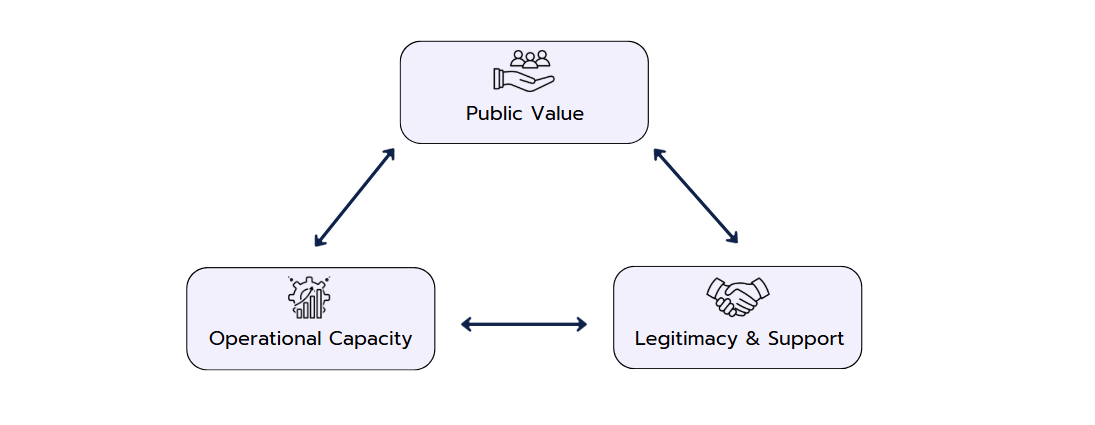The Strategic Public Value Triangle is a conceptual framework developed by Prof. Mark H. Moore to guide public managers in creating public value. It emphasizes the interplay between three key elements: public value proposition, the operational capacity to deliver, and the legitimacy and support of the authorizing environment.

Prof. Mark H. Moore is a distinguished academic known for his work in public management and leadership. He is the Hauser Professor of Nonprofit Organizations at the Harvard Kennedy School. Moore's research and teachings have significantly influenced the field of public administration, particularly with the introduction of the Strategic Public Triangle in his seminal book "Creating Public Value: Strategic Management in Government" published in 1995.
Advantages and Disadvantages of the Strategic Public Triangle
The Strategic Public Triangle serves as a guiding tool for consultants working in the public sector. It aids them in:
- Identifying the value their initiatives bring to the public.
- Ensuring they have the operational capability to deliver on their promises.
- Securing the necessary legitimacy and support from stakeholders, including political authorizers, beneficiaries, and the broader public.
Advantages:
- Holistic Approach: The Strategic Triangle offers a comprehensive view of public management. It doesn't just focus on the value delivered but also takes into account the means of delivery and the surrounding environment. For instance, when a city plans to introduce a new public transportation system, the triangle would prompt officials to consider not just the efficiency of the system, but also the infrastructure required and the public's reception to the change.
- Flexibility: The framework is versatile and can be applied across various public sector contexts, from local to federal levels. For example, whether a small town is trying to improve its local library services or a national government is overhauling its healthcare system, the Strategic Public Value Triangle can guide decision-making.
- Stakeholder Engagement: The triangle emphasizes the importance of legitimacy and support, ensuring that public managers remain deeply connected with their stakeholders. When a public school district, for instance, wants to revise its curriculum, using the triangle would mean not just focusing on educational outcomes but also engaging with parents, teachers, and students to gain their support.
Disadvantages:
- Complexity: The intricate interplay between the triangle's three elements can be challenging to navigate. For instance, a public health initiative aiming to reduce smoking might deliver public value and have operational capability, but if it doesn't gain the support of certain influential groups, its effectiveness could be compromised.
- Potential for Overemphasis: There's a risk that public managers might focus too much on one element of the triangle at the expense of the others. A city might, for example, pour resources into a state-of-the-art waste management facility (operational capability) but neglect to consider whether the public sees it as a priority (public value) or if it has the political backing needed (legitimacy and support).
- Requires Continuous Monitoring: The dynamics of the public sector mean that the elements of the triangle can change rapidly. A policy that enjoys broad public support today might face opposition tomorrow due to changing political or social climates. For example, a renewable energy initiative that is popular during a period of environmental activism might lose traction if economic downturns shift public focus to immediate job creation.
Alternative Frameworks
Several other management and strategic frameworks can be applied in the public sector, including:
- SWOT Analysis: Evaluates strengths, weaknesses, opportunities, and threats.
- Balanced Scorecard: Focuses on performance metrics across various perspectives.
- PESTEL Analysis: Considers political, economic, social, technological, environmental, and legal factors affecting an organization.
- Logic Model: A tool used to visualize the relationship between resources, activities, outputs, and outcomes of a program.
A Concept for Understanding Public Value
The Strategic Public Triangle, conceptualized by Prof. Mark H. Moore, helps consultants in public management. It underscores the necessity of not only delivering tangible value to the public but also ensuring that the means of delivery are robust and that there's a harmonious relationship with the surrounding political and social environment. While it offers a comprehensive and flexible approach, it also demands astute understanding and continuous engagement from public managers. In an ever-evolving public sector landscape, tools like the Strategic Public Triangle remain indispensable, guiding public servants and consultants alike in their quest to create lasting public value. As with any framework, its effectiveness lies in its application, urging those in the public realm to strike a balance between value, capability, and legitimacy.

